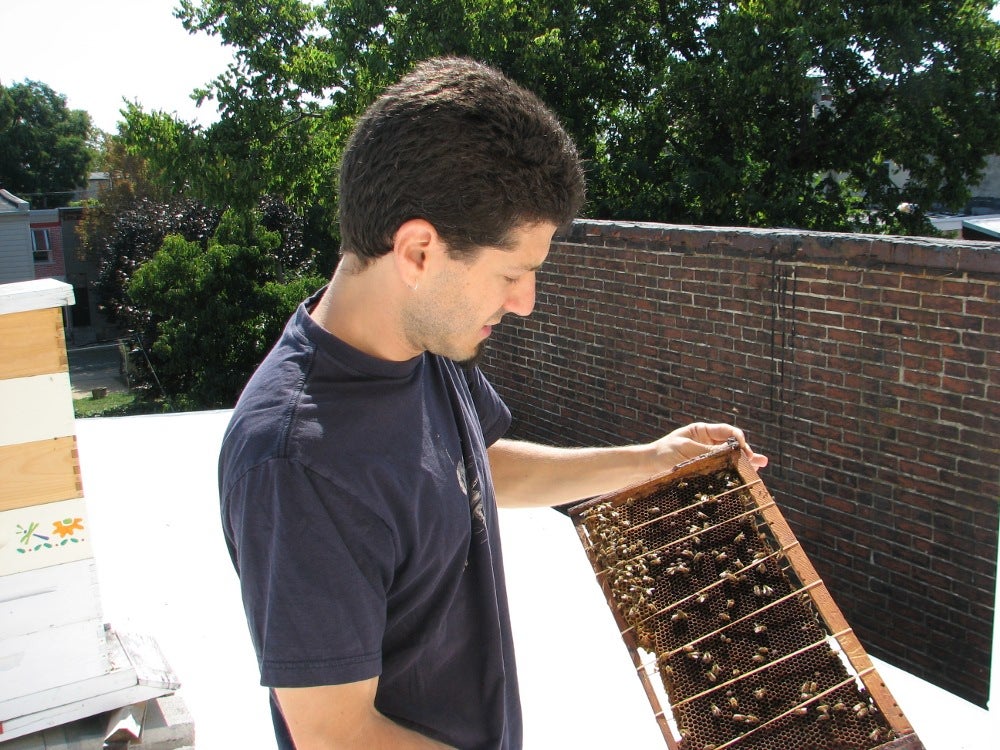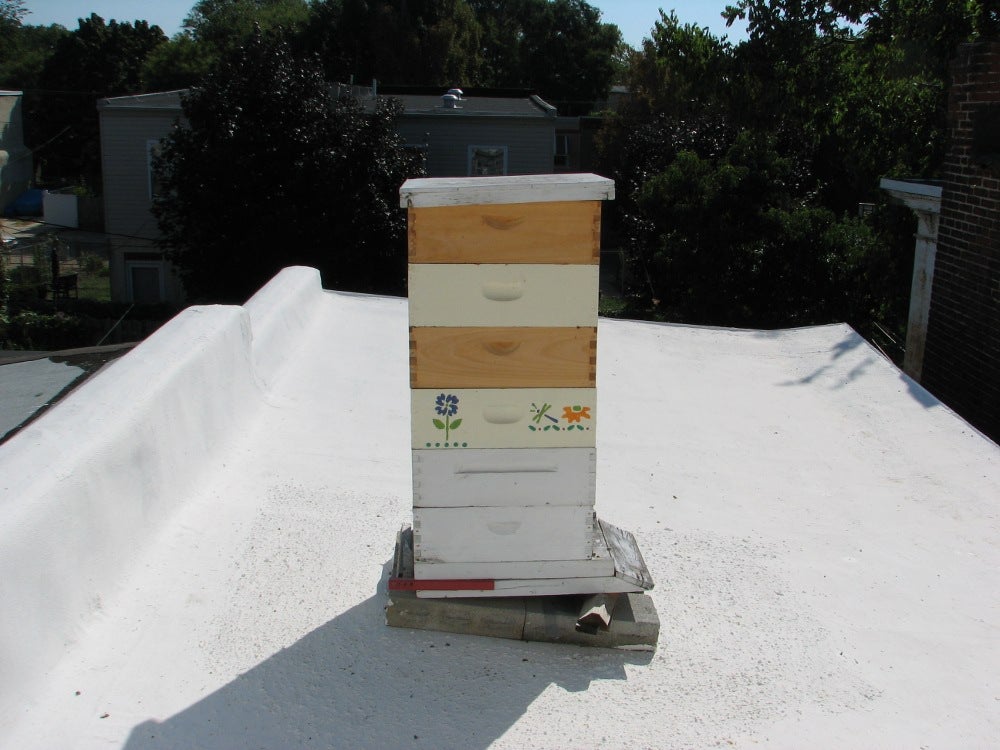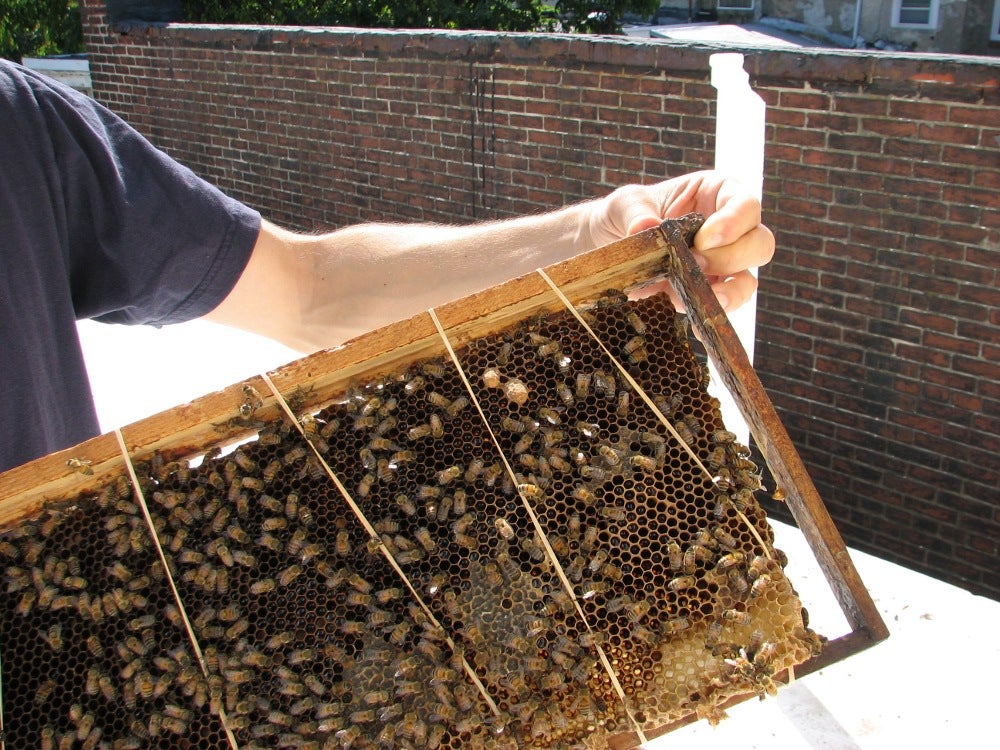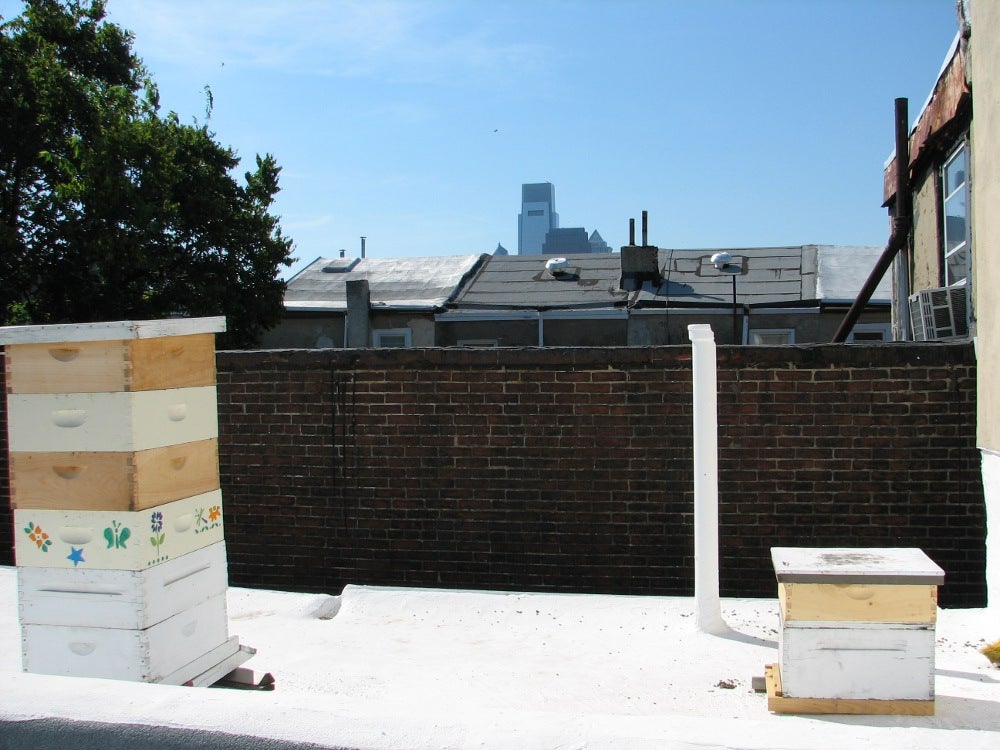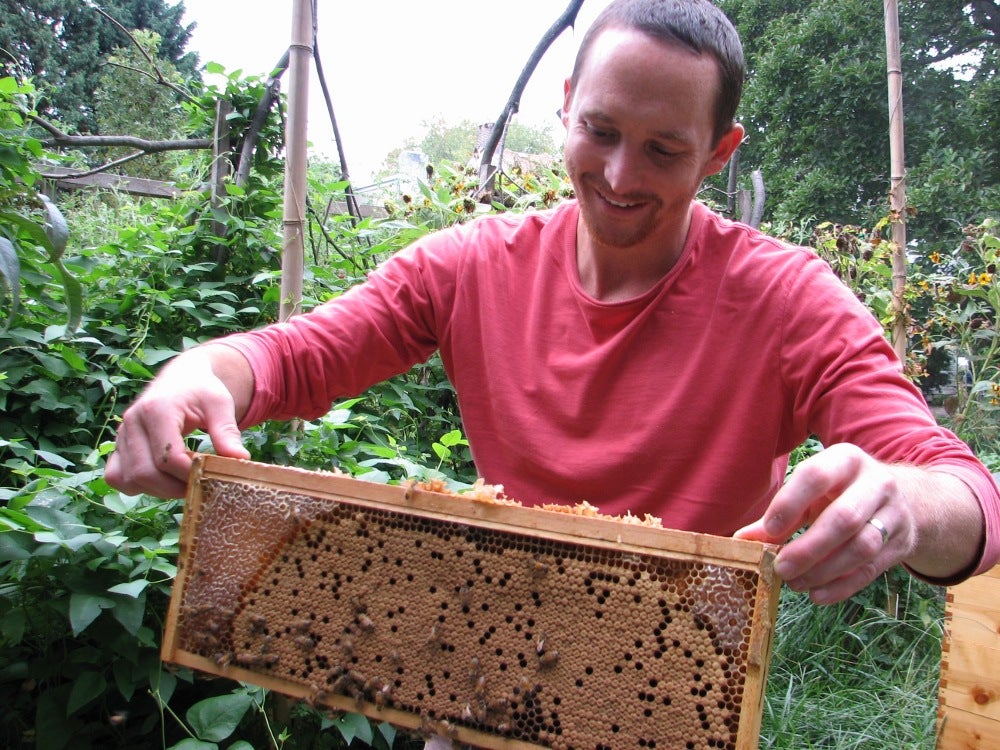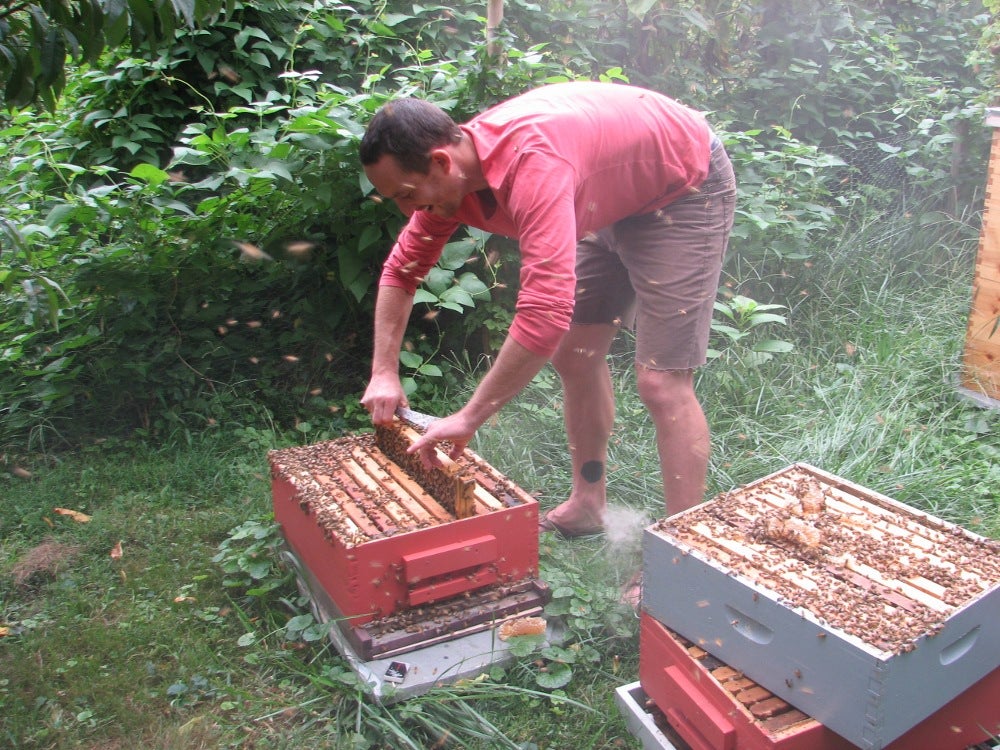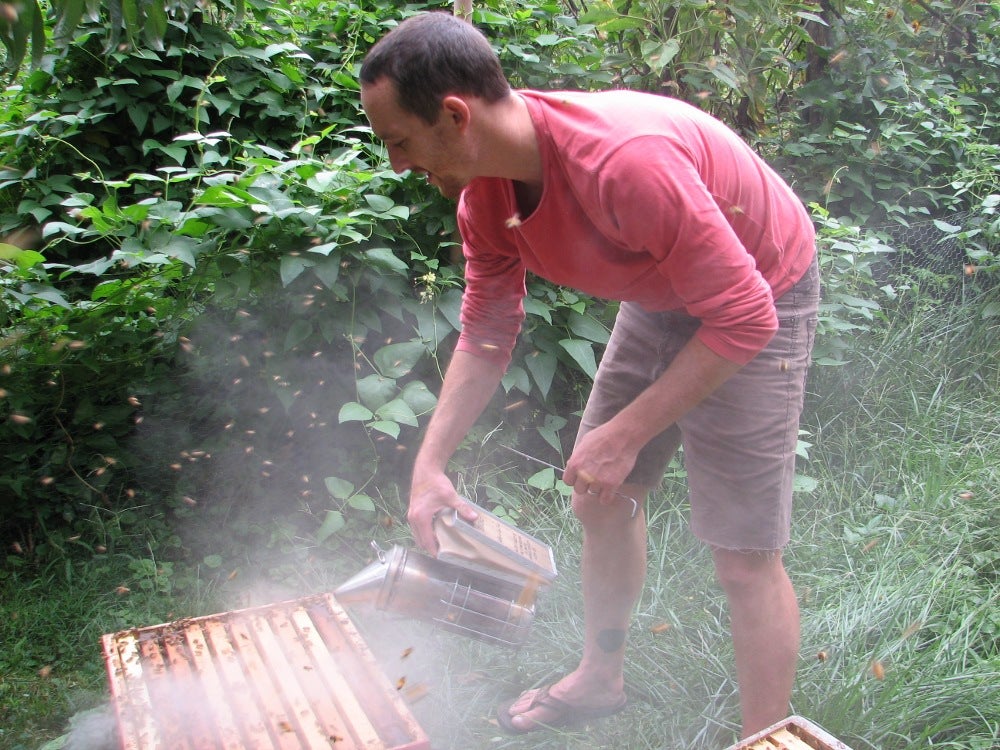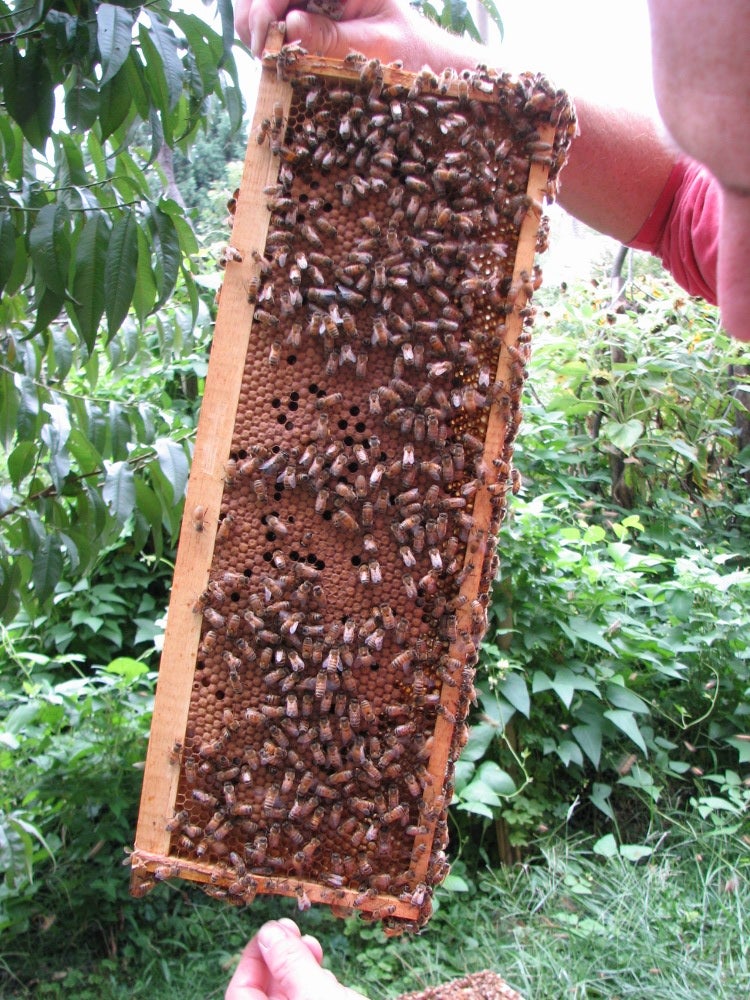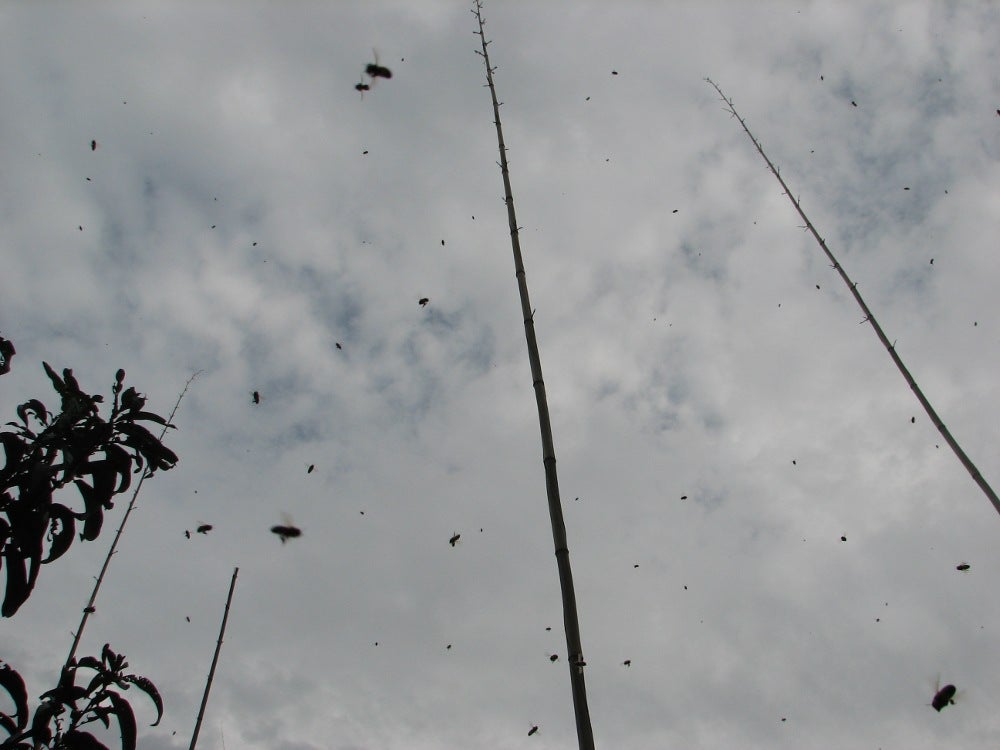Keeping bees in the city
Surrounded by a swirling cloud of honeybees and smoke, a grinning Joel Eckel lifts a frame of waxy hexagons — some filled with future worker bees, others with honey — from one of his backyard hives. The buzz of roughly 80 thousand beating wings nearly drowns out the rush hour traffic on nearby Germantown Avenue.
Eckel points to a cluster of newly hatched white larvae, each one curled up in its own tiny compartment. “The queen has been there recently – within the past four days,” he says.
The Germantown resident is among a growing number of urbanites keeping bees in a backyard, or like Fairmount resident Adam Schreiber, on a rowhouse rooftop.
Hyper local food, helping the bees
Some people are keeping bees because of an increasing interest in local food and at-home food production. But others, a leading bee expert says, are taking up the hobby to help the bees, some of which have been claimed by a mysterious die-off known as Colony Collapse Disorder, when no dead bees are found in an empty hive.
Dennis vanEngelsdorp, a nationally known honeybee researcher at Penn State University who was recently the state’s apiarist — shop talk for beekeeper — says he has witnessed a spike in urban beekeeping, and the trend seems to be growing. “All the beekeeping classes around the Philly are routinely sold out,” he said.
VanEngelsdorp doesn’t keep stats separating beekeepers in urban or rural settings, he said. But he does sequester results by small-scale beekeepers, which include hobbyists, and large-scale, professional operations. The outcomes show that CCD may be contributing to an increase in the hobby — an upsurge of about 20 percent since CCD was discovered in fall 2006, vanEngelsdorp said.
And hobbyists may be having better luck with the disorder than the pros.
According to vanEngelsdorp’s research, U.S. beekeepers with 1 to 50 hives were less likely to lose colonies to CCD than did those with 50 to 500 or more than 500 hives between fall 2008 and spring 2009. Of the 421 respondents with 50 hives or fewer, 16.1 percent reported colony losses with the “no dead bees” symptom, compared to 44.6 percent of the mid-sized producers and 55.4 percent of the largest producers.
It was learning about Colony Collapse Disorder that convinced Suzanne Matlock and her husband, Norman, to keep bees in their Mt. Airy front yard. “All of the documentaries really made us interested in the behavior of the bees, and we wanted to observe it ourselves and maybe contribute to a (CCD) solution,” said Matlock.
CCD is not completely understood. But vanEngelsdorp said “it is clear that colonies that are dying of it are much more heavily effected by viruses – the equivalent of the flu.” The viruses are not consistent, he said, but “we think that is what is causing the symptom of collapse.” The big remaining question: Why are the colonies succumbing to CCD vulnerable to these viruses, when all colonies are exposed to them? VanEngelsdorp said that just like heart disease in humans, there is likely not a single cause.
Matlock, who is a chemist, Eckel, a teacher, and Schreiber, an accupuncturist, say they have not experienced CCD, nor do they know of anyone who has. Schreiber lost a colony in his first year, something he attributes to getting them started too late in the season. Matlock says her bee population is growing “like ivy” and so she has just given some hives to Arcadia University.
Contrary to popular perception, CCD is not the leading cause of colony loss. Many more bees are lost to things stemming from things like starvation, mites, and ill-performing queens, vanEngelsdorp said. And overall, small scale beekeepers have higher bee losses than large scale honey producers do. This could be because the new small scale producers have less experience, vanEngelsdorp said. It could also be because more of them are reluctant to use chemicals to kill mites.
Bee fever is catchy
Both Eckel and Schreiber caught the bee bug from friends who keep them. Eckel’s friend set him up with a hive of his own, and he, his brother Jeff and cousin Abigail now keep six in the large yard Eckel, his wife and kids share with two other homeowners. At the peak of summer, that’s about 300,000 bees.
Schreiber currently has one large hive and a smaller one sitting in the sun reflected by the top of his white roof. The large hive is decorated with butterflies and flowers – a project taken on by his 4 year-old daughter, Jolie, who has a little beekeepers suit of her own. The small hive is filled with a colony of bees Schreiber hopes to save. They had moved into the wall of a Southwest Philadelphia boy’s bedroom – honey was dripping onto the floor – and his parents asked Schreiber to remove them.
Schreiber had very little hope that the colony would survive. The recent process of moving them – with which Eckel assisted – killed many bees, including the queen. And it was late in the season for the hive to recover. But Tuesday morning, he discovered two queen cells in the honeycomb. These cells are much larger and bumpy, and they represent the worker bee’s efforts to tend to a larvae in such a way that they will become egg-laying queens. “The first to hatch will likely kill the other,” Schreiber said. To follow these bee exploits, check out Schreiber’s blog.
There’s a lot of drama in every hive – not to mention a myriad of bee keeping philosophies. Last fall, Eckel and a handful of other Philadelphia beekeepers started holding informal meetings at Germantown’s Wyck House so they could learn from each other. The response was so overwhelming that the Philadelphia Beekeepers Guild was established. It now has more than 60 active members and about 100 people on its email list.
Celebrating a famous Philly beekeeper, and all things bee and honey
And just as the guild celebrates its first birthday, they, along with Wagner Free Institute of Science, Wyck House and Bartram’s Garden, are holding the first Philadelphia Honeyfest this Friday, Saturday and Sunday, with the goals of teaching all who come about the wonders of bee and honey, and properly celebrating the 200th birthday of the father of American beekeeping, native Philadelphian Lorenzo Langstroth, who invented the modern beehive.
Langstroth, a minster and principal of schools in Pennsylvania and Massachusetts who took up beekeeping as a hobby, was living in Massachusetts when he designed a hive with removeable frames – the same sort used by the vast majority of beekeepers today. But he was born Dec. 25, 1910 at 106 South Front Street, where a historic marker will be placed at 3:30 p.m. Friday. Langstroth was a member of the Academy of Natural Sciences, and the frames he invented were built in Philadelphia.
The frames hang in boxes called supers like files hanging in the drawer of a filing cabinet. Each super contains nine or 10 frames, Eckel says. “You can take them out and see what’s going on,” he said as he continued to do just that.
Langstroth is sometimes credited with discovering “bee space” – the concept that bees will fill anything larger than 3/8 of an inch with beeswax, and anything smaller with propolis – a substance bees make from tree sap and other substances that they use as a construction and weatherstripping material. Whether or not Longstreth discovered bee space, he used the concept in his invention.
Prior to the modern hive, the bees would put comb and propolis everywhere, and honey could not be removed without ripping something the bees had built apart and making a big mess, Eckel said.
Eckel used a small, flat-ended tool to gently pry up parts of a hive. Popping sounds marked the cracking of some propolis, but the combs of honey were almost all within the removable frames. One small exception made for some immediate sampling of the sweet, golden results of the bees’ labor.
The top super was already almost full of honeycomb. And in this hive and the rest, Eckel said, the top level was for his bees. Even so, he expects to collect 400 pounds of honey this year.
“Urban bee keepers tend to produce a lot more honey” per hive, VanEngelsdorp said. He hears that the hives on the White House lawn are doing very well, in fact. The reason? Something is always in flower in cities and towns, and there is a wide variety of flowering trees and plants, VanEngelsdorp said.
Honey connoisseur-ship
Schreiber, in his second bee-keeping season, said his bees feast on flowers in his neighbors’ window boxes, dandelions and clover in abandon fields, and vegetable- and ornamental flowers in the nearby Spring Garden community garden. “I can tell by the smell and color of the pollen they are bringing in now that they have access to golden rod, but I don’t know where they are getting it,” he said.
The taste and color of the honey itself changes over the course of the season, Matlock said, with spring flower nectar producing a lighter color and taste and fall going on the heavy side.
If honey were beer, Schreiber said, October’s harvest would be a lager, and June’s like a richer IPA. Schreiber has also been surprised to see incredible differences in color and taste in honey that he’s harvested on the same day from his roof-top hives and those he keeps in a small park nearby.
Matlock, who is the prime HoneyFest organizer, hopes that through this event and others, more people learn to savor the differences in honey, as they have learned to appreciate differences in wine, beer and chocolate.
It really is the ultimate local food, she said. A lot of people want to buy local honey because they believe the traces of local pollen it contains help desensitize those with allergies. This is why she calls the honey her front-yard bees produce “19119,” and the honey made by the bees she keeps at W.B. Saul High School of Agricultural Sciences in Roxborough “19128.”
Convincing the neighbors
As Eckel moved down through the layers of his Germantown hive, he waved a metal smoker, about the size of a coffee percolator, over the top. The smoker was filled with smoldering pine needles he collected from the property, and the gesture sent a small aromatic cloud over the bees, like incense flowing over a church congregation.
It is thought, Eckel explained, that the smell of smoke sets off the bees’ forest fire alarm. They prepare for the possible loss of their hive by eating honey to get them through the construction of a new hive, he said, and that pre-occupation with survival is thought to distract them from the comparatively enormous being who has entered their hive.
Watch anything about beekeeping on television, and you’re likely to see someone wearing a big, white suit, gloves, and what looks like a safari hat with a veil of netting. Eckel has one of those suits, but he never uses it anymore. He carried the hat out to the hives, just in case the stormy weather had the bees “in a bad mood.” But it stayed on the ground where he dropped it, between the hives and the chicken coop.
By the time Eckel reached the last layer of his hive, a lot of bees were flying around. But he did not get stung. (I did once, but only because I accidentally knelt on a bee who was sitting in the grass.)
“They are very gentle animals,” Matlock said. But still, they do come equipped with a stinger and venom, and some people fear them – especially if they are allergic to bee stings. “A lot of times people do object to having a neighbor beekeeper,” she said.
Matlock and her husband discussed it with their neighbors, who were nervous, but who told them to go ahead and “we’ll see what happens,” she said.
Here’s what’s happened: “People walking down the street will say, ‘Your bees were up at our mint! I wonder if your honey tastes like mint?” Some neighbors are planting bee-friendly plants – or allowing their herbs to flower rather than pinching them back.
And then there is the sweetest persuasion. Matlock, Schreiber and Eckel all give away a good amount of what their bees produce.
“Our neighbors leave empty jars on our picnic table, and we know that means so-and-so is out of honey,” Matlock said.
Reach the reporter at kgates@planphilly.com
WHYY is your source for fact-based, in-depth journalism and information. As a nonprofit organization, we rely on financial support from readers like you. Please give today.



